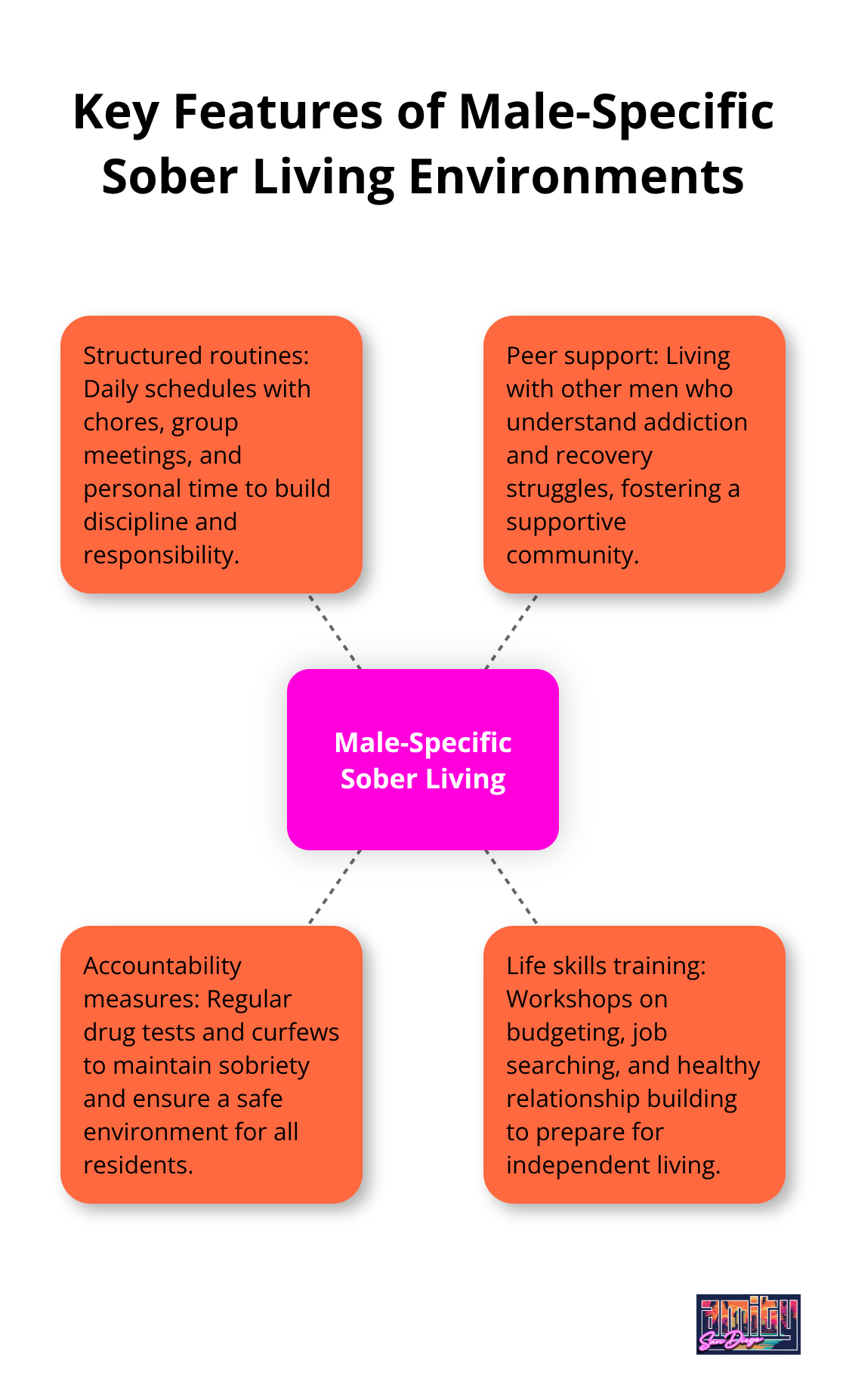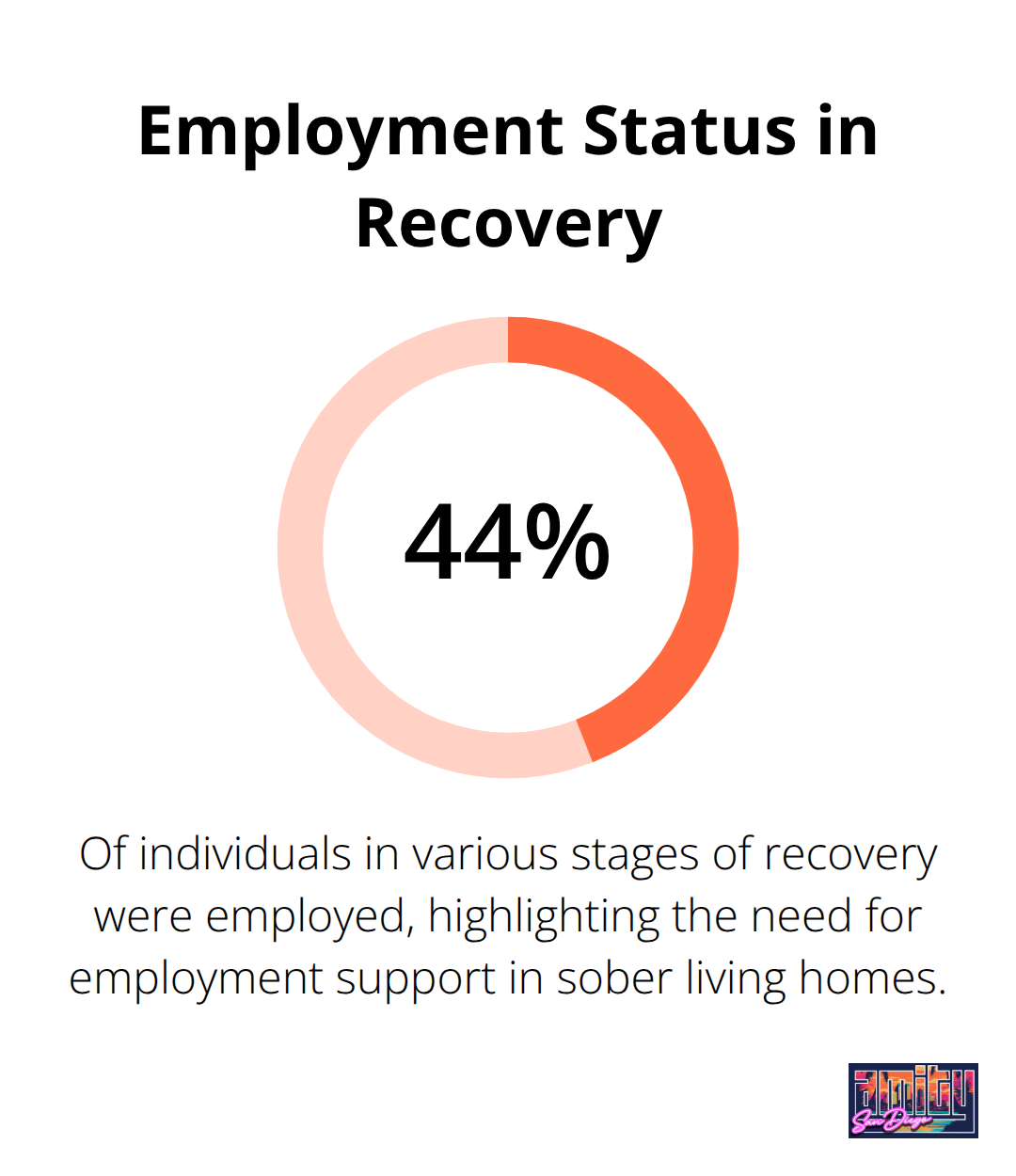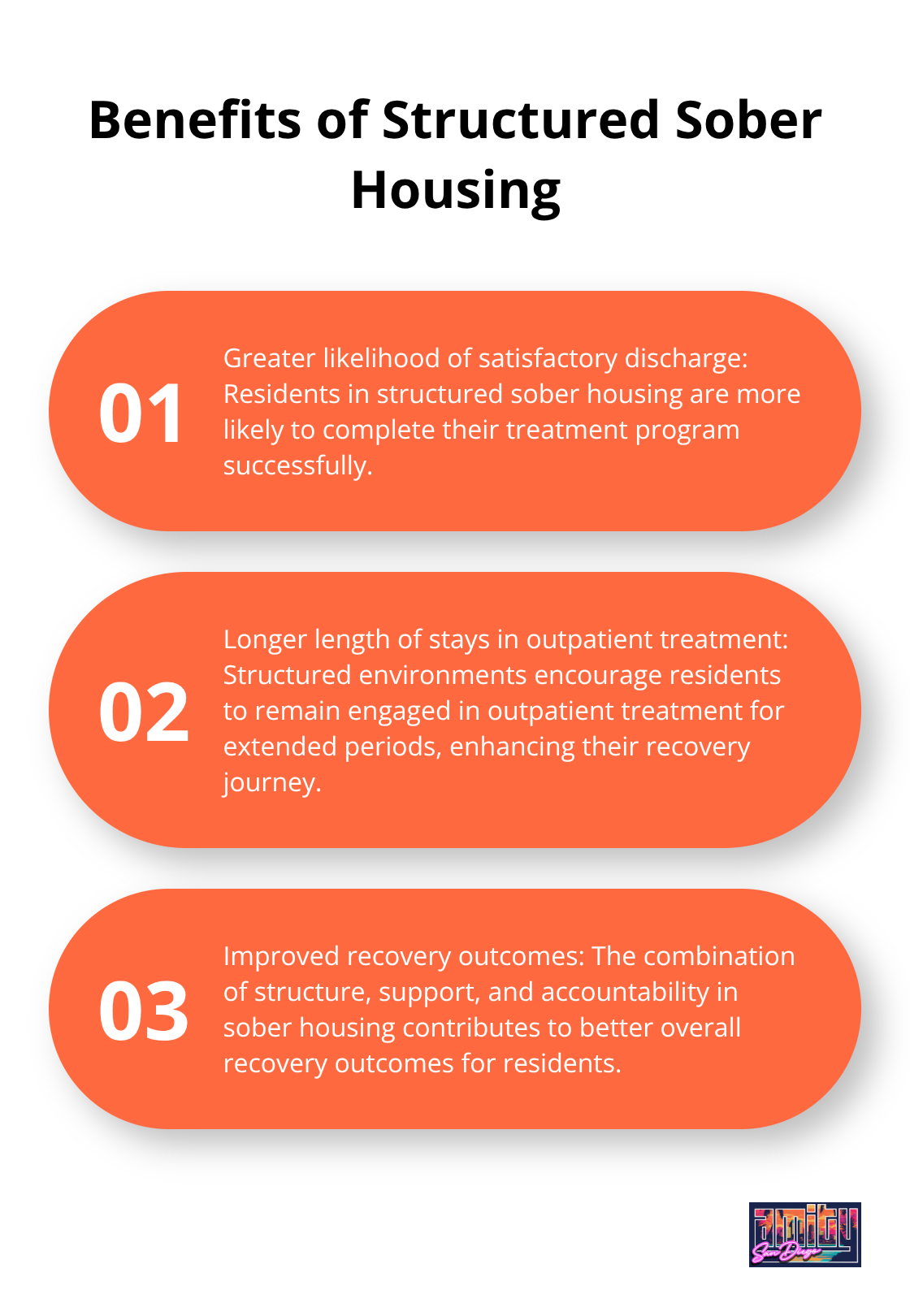At Amity San Diego, we understand the unique challenges men face in recovery. Sober living homes for men offer a structured environment that supports long-term sobriety and personal growth.
This guide explores the benefits of gender-specific recovery settings and provides practical advice for choosing the right sober living home. We’ll also dive into daily life in these facilities and highlight the importance of aftercare in maintaining lasting recovery.
What Are Sober Living Homes for Men?
Definition and Purpose
Sober living homes for men provide structured, substance-free environments that bridge the gap between intensive addiction treatment and independent living. These residences serve as a stepping stone for men who have completed initial treatment but need additional support to navigate daily life. They offer a supportive community, accountability, and an opportunity to practice sobriety skills in a real-world setting.
A study by Polcin et al. (2010) revealed significant improvements in alcohol and drug use for residents in sober living homes. Involvement in 12-step groups was associated with reductions in alcohol and drug use.
Key Features of Male-Specific Environments
Male-specific sober living homes address unique challenges men face in recovery. These environments typically include:

- Structured routines: Daily schedules with chores, group meetings, and personal time
- Peer support: Living with other men who understand addiction and recovery struggles
- Accountability measures: Regular drug tests and curfews to maintain sobriety
- Life skills training: Workshops on budgeting, job searching, and healthy relationship building
Benefits of Gender-Specific Recovery
Gender-specific recovery settings offer several advantages:
- Reduced distractions: Removal of potential romantic entanglements allows residents to focus on recovery
- Tailored programming: Addressing male-specific issues (e.g., societal expectations, fatherhood, masculine identity)
- Open communication: Men often feel more comfortable discussing sensitive topics in all-male groups
Gender-specific environments during this vulnerable time can provide the focused support needed to maintain sobriety while building essential skills.
The Power of Peer Support
In male-specific sober living homes, residents often form strong bonds and support networks that last well beyond their stay. These connections (which can include sponsorship relationships and accountability partnerships) prove invaluable in maintaining long-term sobriety and rebuilding lives post-treatment.
Transitioning to Independent Living
Sober living homes provide a gradual transition to independence. Residents learn to balance recovery with work or education, manage finances, and develop healthy coping mechanisms. This structured environment allows men to build confidence and self-reliance as they prepare for life outside the recovery home.
As we explore the process of choosing the right sober living home, it’s important to consider how these key features align with individual needs and recovery goals.
Selecting the Right Sober Living Home for Men
At Amity San Diego, we know the importance of choosing the right sober living home. This decision can significantly impact long-term sobriety. Here’s what you need to consider when making this critical choice.
Location: A Key Factor
The location of your sober living home plays a vital role in recovery. We recommend homes in areas with low crime rates, away from known drug hotspots. A study found that greater neighborhood densities of substance abuse services and AA groups may help residents achieve more days abstinent. Consider the proximity to work, support meetings, and public transportation when making your choice.
House Rules and Structure
Each sober living home operates under its own set of rules. Common rules include:
- Mandatory drug tests
- Curfews
- Chore assignments
- Meeting attendance requirements
We advise you to request a written copy of house rules before making a commitment. Homes with clear, enforced rules often lead to better outcomes. Research indicates that sober living houses (SLHs) are alcohol and drug free living environments that offer peer support for recovery outside the context of treatment.
Staff Qualifications Matter
Don’t hesitate to inquire about staff credentials. We suggest looking for homes with certified addiction counselors or recovery coaches on staff. The Substance Abuse and Mental Health Services Administration (SAMHSA) emphasizes the importance of qualified personnel in recovery settings.
Watch Out for Red Flags
Be cautious of homes that:
- Promise unrealistic success rates
- Have no screening process for new residents
- Lack clear policies on relapse
- Offer unusually low rent (which could indicate overcrowding or subpar conditions)
A reputable sober living home should provide transparency about their operations and success metrics.
Peer Support and Community
The power of peer support cannot be overstated. We recommend looking for homes that foster a sense of community through group activities and shared meals. Studies have demonstrated increased treatment retention, improved relationships with treatment providers and social supports, increased satisfaction, and reduced substance use associated with peer support services.
When you tour potential homes, pay attention to how current residents interact. Do they support each other? Do they seem engaged in their recovery? These observations serve as good indicators of a healthy living environment.
As we move forward to explore daily life in men’s sober living homes, keep these selection criteria in mind. The right environment (with proper structure and support) will provide a solid foundation for your recovery journey.
A Day in the Life at Men’s Sober Living
Early Morning Routines
Men’s sober living homes start the day early, often at 6:00 AM. Residents make their beds, complete assigned chores, and prepare for the day ahead. This structure builds discipline and responsibility (key components of long-term recovery).
Most homes require participation in morning meditation or group check-ins. These sessions set a positive tone and allow residents to voice concerns or challenges. The Journal of Psychoactive Drugs found that residents who actively participated in house activities had significantly better outcomes in maintaining sobriety.
Balancing Recovery and Real-Life
After morning routines, residents head out to work, school, or volunteer commitments. This integration of recovery with daily life allows men to practice new coping skills in real-world situations while maintaining a safe, supportive environment to return to.
Many sober living homes partner with local businesses or educational institutions to help residents find employment or continue education. A study found that fewer than half (44.5%) of individuals in various stages of recovery were employed, highlighting the importance of employment support in sober living homes.

Evening Activities and Peer Support
Evenings focus on recovery-oriented activities, which might include:
- 12-step meetings (in-house or at local venues)
- Group therapy sessions
- Life skills workshops (budgeting, cooking, conflict resolution)
- Fitness activities or yoga classes
Peer support thrives during these evening hours. Residents often gather for communal dinners, share daily experiences, and offer encouragement to one another. This camaraderie proves invaluable in building a strong recovery network.
Tools for Maintaining Sobriety
Successful sober living homes provide tools to help residents navigate group living:
- Conflict resolution training: Addressing disagreements in a healthy, non-confrontational manner
- Accountability partnerships: Pairing residents to support each other’s sobriety goals
- Regular house meetings: Addressing issues within the home and celebrating milestones
- Personal goal-setting sessions: Working with staff to set and review individual recovery objectives
Research shows that living in structured sober housing was associated with greater likelihood of satisfactory discharge and longer length of stays in outpatient treatment.

Creating a Supportive Environment
Men’s sober living homes foster a culture of mutual support and accountability. Residents learn to rely on each other, share experiences, and work together towards common goals. This supportive atmosphere (combined with structured routines and professional guidance) creates an ideal setting for men to rebuild their lives and strengthen their commitment to sobriety.
Final Thoughts
Sober living homes for men provide a powerful stepping stone in the journey to lasting recovery. These structured environments offer support, accountability, and community necessary for men to rebuild their lives after addiction. Men often find it easier to address sensitive issues in all-male environments, which allows for tailored programming that addresses male-specific recovery needs.
The transition from intensive treatment to independent living can challenge individuals in recovery. Sober living homes bridge this gap effectively and provide a gradual return to normalcy while maintaining a strong support network. These homes allow residents to practice sobriety skills while navigating real-world challenges (such as employment and relationships).
We at Amity San Diego offer comprehensive outpatient programs designed to support long-term recovery. Our evidence-based approach combines medical expertise with personalized care, addressing both addiction and co-occurring mental health issues. Take the first step towards sober living by researching reputable homes in your area, considering factors like location, house rules, and staff qualifications.

